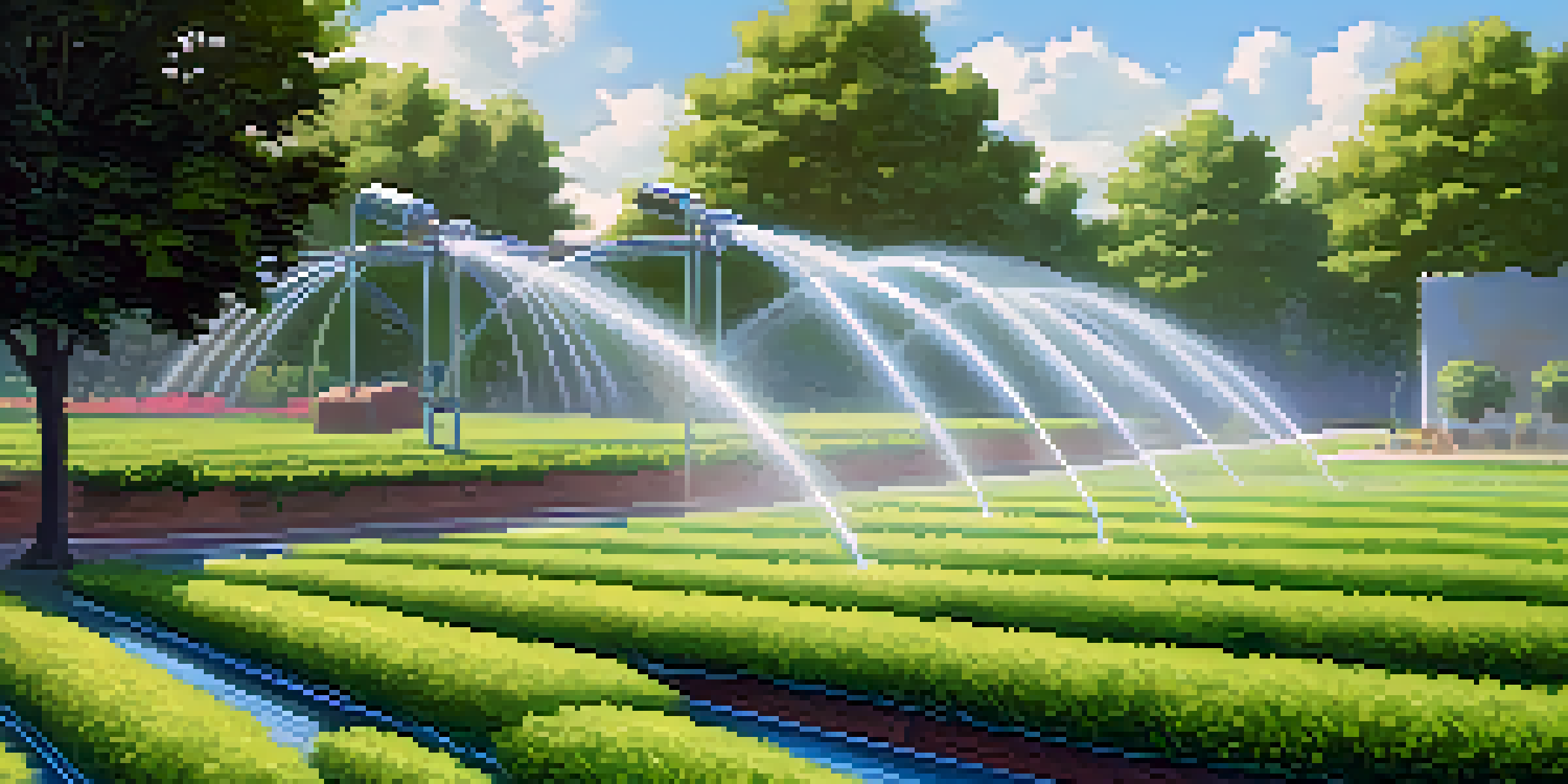Integrating IoT for Smart Water Management Solutions

Understanding IoT in Smart Water Management
The Internet of Things (IoT) refers to the network of devices connected to the internet, allowing them to collect and exchange data. In smart water management, IoT plays a crucial role by using sensors and connected devices to monitor water usage and quality in real-time. This integration not only enhances efficiency but also helps in conserving precious water resources.
Water is the driving force of all nature.
Imagine a smart irrigation system that adjusts itself based on weather forecasts and soil moisture levels. This is just one example of how IoT can optimize water use in agriculture, ensuring that crops receive the right amount of water without wastage. By providing actionable insights, IoT empowers both businesses and consumers to make informed decisions about their water usage.
Ultimately, understanding the role of IoT in water management is the first step toward embracing these innovative solutions. As we explore further, we’ll uncover how these technologies can create a more sustainable future for our planet.
Benefits of IoT for Water Resource Management
Integrating IoT in water management systems offers numerous benefits, including improved efficiency, reduced costs, and enhanced sustainability. For instance, smart meters can help track water usage patterns, allowing users to identify leaks and wasteful practices. This proactive approach not only saves money but also promotes responsible water consumption.

Moreover, IoT technology can assist in detecting water quality issues by continuously monitoring parameters such as pH, turbidity, and contamination levels. When any anomalies are detected, alerts can be sent immediately, enabling swift action to address potential health risks. This capability is especially critical in ensuring safe drinking water for communities.
IoT Enhances Water Management
Integrating IoT technologies allows for real-time monitoring and improved decision-making in water resource management.
In essence, the benefits of IoT in water resource management extend beyond mere convenience; they contribute to a more sustainable and responsible approach to using our planet's most vital resource.
Key Technologies in IoT Water Solutions
Several key technologies underpin the success of IoT in water management, such as sensors, data analytics, and cloud computing. Sensors are placed at strategic locations to gather real-time data about water flow, pressure, and quality. This data is then transmitted to the cloud, where it can be analyzed to derive meaningful insights.
The greatest threat to our planet is the belief that someone else will save it.
Data analytics plays a pivotal role in transforming raw data into actionable information. By leveraging machine learning algorithms, organizations can predict water demand, identify potential leaks, and optimize distribution networks. This level of insight allows for smarter decision-making and planning.
Lastly, the cloud serves as a centralized hub for data storage and access, ensuring that stakeholders—from city planners to individual users—can access real-time information anytime, anywhere. Together, these technologies create a robust ecosystem for smart water management.
Challenges in Implementing IoT Solutions
Despite the many advantages, implementing IoT solutions for water management is not without its challenges. One significant hurdle is the initial cost of deploying sensors and other technologies. For many municipalities and companies, the upfront investment can be daunting, especially if budgets are tight.
Additionally, ensuring the security and privacy of data collected by IoT devices is paramount. With the rise in cyber threats, water management systems must implement stringent security measures to protect sensitive information. This often requires ongoing investments in technology and training for staff.
Benefits of Smart Water Solutions
Smart water management through IoT leads to increased efficiency, cost savings, and better sustainability practices.
Finally, there’s the challenge of integration with existing infrastructure. Many water systems are outdated, and retrofitting them with new technologies can be complex. However, overcoming these challenges is essential for harnessing the full potential of IoT in water management.
Case Studies: Successful IoT Water Management
Several cities around the globe have successfully integrated IoT solutions into their water management systems, serving as inspiring examples. For instance, Barcelona has implemented smart water meters that provide real-time usage data to residents and city planners. This initiative has led to a significant reduction in water waste and increased awareness among users.
Another notable example is Singapore, which employs a comprehensive network of sensors to monitor and manage its water supply. By utilizing data analytics, the city can predict demand and optimize distribution, ensuring that water resources are used efficiently. This proactive approach has earned Singapore a reputation as a leader in smart water management.
These case studies illustrate that with the right technology and commitment, cities can transform their water management practices, creating more sustainable and resilient systems.
The Future of Smart Water Management
As technology continues to evolve, the future of smart water management looks promising. Advances in artificial intelligence (AI) and machine learning will enhance the capabilities of IoT systems, enabling even more sophisticated data analysis and predictive modeling. This could lead to more effective water conservation strategies and improved infrastructure planning.
Moreover, public awareness and engagement are likely to grow as citizens become more informed about the importance of water conservation. As communities adopt smart water solutions, we can expect a cultural shift towards more responsible water usage practices, driven by data and technology.
Challenges in IoT Implementation
Despite its advantages, the deployment of IoT solutions faces hurdles such as high initial costs and data security concerns.
Ultimately, the integration of IoT in water management is not just about technology; it's about fostering a sustainable mindset that prioritizes the health of our planet. By embracing these innovations, we can ensure a brighter future for our water resources.
Getting Started with IoT Water Management
For businesses and municipalities looking to integrate IoT into their water management strategies, the first step is to assess their current systems and identify areas for improvement. This may involve evaluating existing infrastructure, pinpointing inefficiencies, and determining the data that needs to be collected.
Once you have a clear understanding of your needs, the next step is to choose the right technology partners. Collaborating with experienced IoT providers can help ensure a successful implementation. They can offer guidance on selecting the right sensors, data analytics tools, and security measures tailored to your specific requirements.

Finally, ongoing training and support are essential for maximizing the benefits of IoT solutions. By investing in staff education and fostering a culture of continuous improvement, organizations can adapt to changing technologies and practices, ultimately leading to more sustainable water management outcomes.